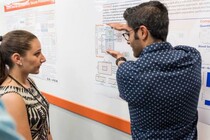Smarter Phones, Faster Drones, Thinking Robots
CAMBRIDGE, MA – It was a day of scientific breakthroughs recently at Draper when new research was presented by 25 graduating Master’s and PhD students whose graduate study has been supported by the Draper Fellow Program. The research was wide-ranging, but the applications were real-world: robots that can think, space suits that can feel, prosthetics that can soothe nerves and satellites that can talk to your phone.
The event was the Graduating Draper Fellow Highlights Poster Session, in which graduating Fellows present their thesis research in addressing and solving some of the most challenging technology and engineering problems.
The 2017 celebration did not disappoint. Will Tomlinson, a PhD graduate from Northeastern University, presented technology to use the body’s naturally generated bioelectrical signals to verify a person’s identity—a method that may prove tougher to spoof than fingerprint, facial recognition and iris/retina based-detection.
Another student, Mitchell Plyler, a Master’s graduate from MIT, explained use of machine learning to improve the precision of airdrops for military and humanitarian aid, a technique that can help avoid lost, damaged and captured aerial supplies. Ryan Silva, a PhD graduate from Boston University, refined a technique to separate blood and bacteria using acoustics, a promising improvement over the more cell-damaging process used in a centrifuge.
The 2017 Draper Fellows graduating class includes 25 students from Boston University, Brown University, Harvard University, the Massachusetts Institute of Technology, Northeastern University, Tufts University and the University of Massachusetts, Lowell. Each year the program typically sponsors the tuition and stipend of 55-65 graduate students.
Sheila Hemami, Director of Strategic Technical Opportunities at Draper, said the focus of the program, which she directs, is identifying and solving challenging research problems, and then demonstrating the validity of the solutions in appropriate applications. “By combining the requirement for scientific and engineering innovation with a real-world application, we push the research not only in the direction of a scholarly contribution but also in the direction of impact. The Draper Fellow Program provides students with the opportunity to actualize their research results.”
Alumni of the Draper Fellow Program, founded in 1974, comprise more than 1,200 Draper Fellows from both civilian and military backgrounds and who are excelling worldwide in technical, corporate, government, academic and entrepreneurship sectors. Notable alumni include military officers, executives at Fortune 500 companies and five NASA astronauts.
Details about the program, including how to apply, are available at Draper.
Released June 2, 2017










